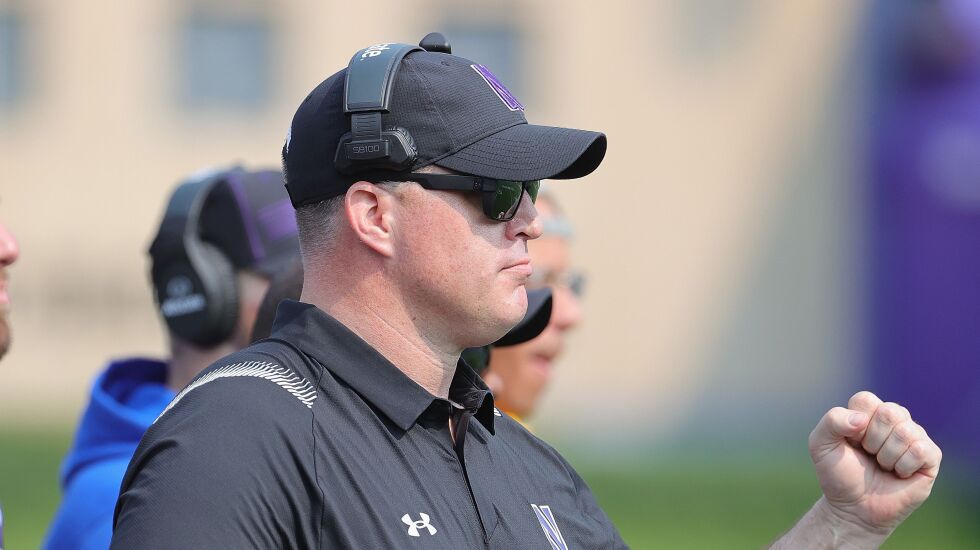
Northwestern didn’t know how much it yearned for the college football experience until the fun arrived — magically and unexpectedly — in 1995. After decades of athletic embarrassment, the Wildcats won 10 games for the first time in school history and went to the Rose Bowl. NU finally had something worthy of a tailgate party, and it didn’t want that party to end.
The success led to dreams of sports excellence that would match the university’s educational excellence. Eventually, thanks to donor money, sports programs were upgraded, better facilities were built and alumni were stoked. Doctors and lawyers who hadn’t seen much winning when they had attended NU became football fanboys and fangirls. Even grads with a degree from the just-the-facts Medill School of Journalism proved as hungry for a winner as any physical-education major from Ohio State.
But there’s a price to be paid for wanting to be big-time, and Northwestern is finding that out now in a very painful and public way. A hazing scandal that cost coach Pat Fitzgerald his job has subjected the school to the type of unseemly PR it once associated with football schools that had Southern drawls.
Northwestern surely didn’t want embarrassment and notoriety when it made decisions to compete with the big boys athletically, but that’s what it received nonetheless.
Scandals happen at colleges small and large, but the fallout is much bigger when they happen at one in the national spotlight. Now Northwestern is dealing with a massive blow to its lofty reputation. Calls to delay a proposed new football stadium, which was already controversial, have increased.
The football coach is gone, as is baseball coach Jim Foster, who recently was fired for alleged bullying the school considered toxic. Athletic director Derrick Gragg should be gone, too, for overseeing this sad circus. And if university president Michael Schill were to get the heave-ho, there probably wouldn’t be many tears shed outside of his immediate family. He initially gave Fitzgerald a soft, two-week suspension for a lack of institutional control, then fired him a few days later under public pressure.
Northwestern didn’t make a deal with the devil when it sought more success on the field of play, but the two became nodding acquaintances with that decision. There’s a cost to ambition in big-time college sports, and NU is finding out what it is.
There was a stretch during the 1980s when NU thought about getting out of the Big Ten because its football teams were getting pounded by the obvious suspects (Michigan and Ohio State) but also because they were getting beaten regularly by schools in the lower echelons of the conference. Those were more quaint times, when intellectual integrity could lead a school to have what might be considered an uncomfortable discussion.
But Northwestern eventually decided to do what it could to be like Duke, which had managed to build a prestigious basketball program under coach Mike Krzyzewski while maintaining a sterling educational reputation. Once NU pointed its ship in that direction, there were few voices in the university community talking about sports becoming too big. No, most of the voices were saying, ‘‘Rah!’’
Now that still-rigorous academic institution is wondering what it has wrought. Does it want the sometimes-uncomfortable attention that comes with high-level athletics? Does it want the coaches with the big contracts (Fitzgerald had a 10-year, $57 million deal with Northwestern)? Does it want the reputational hit that comes with a hazing scandal in which upperclassmen allegedly dry-hump freshmen for mistakes made on the field?
Is it all worth it? That’s something the students, the faculty, the administration and the board of trustees will have to decide. But one thing is for sure: It will be difficult to turn around the ship now.
When Northwestern built a $270 million athletic facility in 2018, the school said the new building would enable the Wildcats to compete with Big Ten schools that had bigger coffers. That certainly hasn’t happened for the football program, which has gone 23-36 since the Ryan Fieldhouse and Walter Athletics Center opened.
The irony is that the building was conceived with one person in mind: Fitzgerald. In 2011, Michigan officials came to Evanston to try to hire him for their vacant head-coaching position. But Northwestern officials and the school’s fairy godfather, Aon founder Pat Ryan, met with Fitzgerald and asked him what it would take for NU to compete with the Big Ten’s biggest guns. Fitzgerald’s ideas are the backbone of the 425,000-square-foot temple to Northwestern sports, but most specifically to Northwestern football.
Fitzgerald chose not to interview with Michigan.
Five years later, NU has a beautiful practice facility, a few ugly scandals on its hands and a whole lot of attention it didn’t remember asking for.







